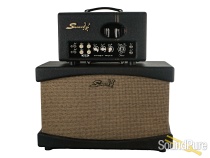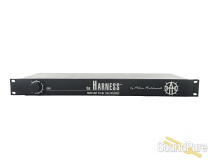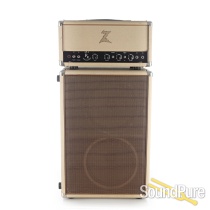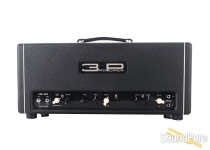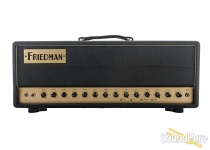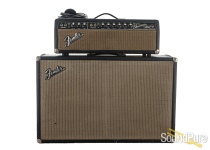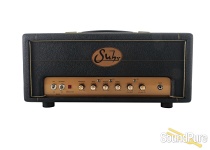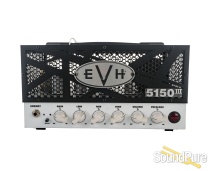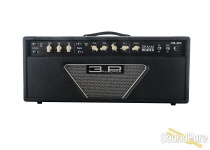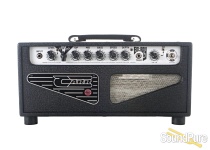-
Call Us Toll Free888-528-9703
-
Local/International (+1)919-682-5552
- Call Us! Toll Free! 888-528-9703
- Local / International (+1) 919-682-5552

Nolatone Road Hogg 50 Guitar Amplifier Head - Used From Nolatone
Blackface Bassman to full-on Marshall Plexi! This is a true Road Warrior!
"Gone, Baby, Gone"
This one is sold. Don't miss the next one. Some things never even make it to the site so stay up to date on our used collection.
We get in many oddities, rare and vintage products, most of which go fast. If you're on the hunt for something specific, something unique, or something priced right, let us notify you on our used collection before the items even hit the site.
Want to know if one lands?
Notify MeWant to discuss what's coming?
What We Think
The Nolatone vibe for their combos has always been to get the absolute most sound and tone out of the smallest space possible. So when they set their minds to making a 50 watt head...look out! The beauty of the Road Hogg 50 is in its pedigree. Taking nods from all points of the Marshall Plexi lineage, this head can do dynamic, bold cleans and jump right into the Plexi-style 'grunt' at the flick of a switch.
This particular head isn't just a Road Hogg...it's a Road WARRIOR. It's seen its fair share of gigs but that adds to its charm as not just a great amp but a piece of gear with both a conceptual and physical history. Don't miss out on this one!
Manufacturer's Description from Nolatone
Road Hogg 50
Imagine being able to get Plexi tones and Blackface Bassman tones (but without the flabby bottom) from the same amp. The Road Hogg series amps allow you to do JUST that!
The Road Hogg preamp starts with a Plexi toplogy, but with some very powerful modifications that allow you to choose if you want that classic Plexi midrange, or scoop that out and reveal a cleaner decidedly more Bassman-like tone, and selecting between these modes is foot-switchable! Read "The Full Story" below for all the details on how I make this happen.
The Road Hogg 50 is the loudest member of the Road Hogg Family of amps (until someone asks to build the Road Hogg 100!). Fixed Biased EL34s into a beefy Mercury Magnetics Plexi style output transformer make for a loud and punchy beast! Classic 50 Watt Plexi output section with all the authority!
Use it for loud cleans or go primal and open it on up and let the power section sing for the majestic experience of a cranked Plexi. There's nothing quite like it!!
Classic Plexi grunt and crunch with plenty of clean volume for your pedal platform. The most clean volume of all the Road Hoggs.
As with every other member of the Road Hogg family, the 22 is ultra dynamic, responding to pick attack and even the most subtle nuance of player and guitar. It also makes a fantastic pedal platform.
NOTE: The Road Hogg is NOT a Plexi clone!
It starts with the basis of the venerable Plexi circuit and builds on it to offer so much more.
Road Hogg: A Tale of Two Heads
The Short Story
Imagine how nice it would be to if you could have a Plexi and a Blackface Bassman on stage for all your gigs. When you want that midrange rich Plexi crunch, you would switch over to the Plexi, but when you needed less of that and a cleaner, less crunchy tone, you could switch over to the Bassman. With the Road Hogg series amps you can have that, without having to drag two amps out. But how you ask? Well, you can't get Plexi from a Bassman, but if you pull the right swath of that midrange, you CAN get a Plexi to sound quite Fender-esque. That is just what the Road Hogg does. It uses a (slightly modified) Plexi preamp with the same tone stack, but instead of a panel mounted mid control, the Plexi mid is set with an internal trimpot (allowing you to tweak it for your preference). I pre-set it to the equivalent of the mid at about 2'oclock on a traditional Plexi. This is what you hear when you engage the "Plexi Boost" feature. We've added a separate Mid control after the Plexi tone stack. This filter allows that Plexi midrange to be pulled out and transforms the Hogg into something more like a BF Bassman (or any number of other amps you might be reminded of depending on how you dial that mid control). It is in effect when Plexi Boost is turned off and is bypassed when Plexi Boost is turned ON.
This is how you get the benefit of two amps in one.
1 Channel vs 2 Channels?
Q: But what about the 2 channels of a Plexi? The Road Hogg only has one input? A: The Road Hogg accomodates the tones of both the treble and normal channels of a Plexi with the Bright Switch and TBright Blend controls. A classic Plexi uses half of a 12ax7 dual triode for each channel. The Normal input feeds one half, the Treble input feeds the other. The Road Hogg uses a pentode input stage for better pedal compatibility, and a pentode only has one input. The Bright switch and Bright blend controls incorporate the interaction between the two channels of a Plexi. How? Read on...
Bright Blend
Some of you may have noticed that if you plug into the normal channel of a Plexi, the treble channel volume control adds more treble and gain as you turn it up, even though there is nothing plugged into that channel. This is what the Bright Blend control on the Road Hogg does in Normal Mode. This is very useful as it allows you to tune the treble response and gain of the Normal Mode for your guitar and taste.
Bright Switch
Engaging the Bright switch selects Bright Mode. This internally reconfigures the input circuitry to that of the Plexi Treble channel, essentially the same as plugging into the Treble channel of a Plexi. You will notice a nice bump in treble that is great for making darker guitars cut and getting that edgier tone.
The Plexi in it's various forms holds one of the most prominent places in the classic sounds of the rock and blues music we've been hearing for the past 40 years. There are many reasons for that, not the least of which is the fact that it just *works* for so many styles of music. It just sits in the mix on stage (or in the studio) and could cut and project in the days when PA systems were not what they are today. And that classic glorious tone. Ohhhh the tone!
The way the tone stack in that circuit is configured produces the firmer bottom than it's American counterparts and somehow shapes the low and mid frequencies in a way that just cuts through the mix naturally but without painful harshness, producing a truly classic musical tone.
When I designed the Road Hogg I wanted to offer an amp that pro musicians could easily dial up great tones night after night. An amp that would reward them with a special experience whether they choose to use pedals in front, or crank it up and do the primal old school thing. So it makes sense there is Plexi DNA at the core of the Road Hogg design. That voicing just works.
But what about the guy/gal who finds the Plexi to be just a bit too forward and needs a different midrange to allow more variety of tone with a cleaner amp driven by a variety of pedals for various textures. We often see folks like this opt for a different amp, for example a Black or Blonde Bassman or Bandmaster. With the Road Hogg, you can have a taste of both with a stomp of a footswitch...
Road Hogg Mid Control
The Road Hogg's front panel mid control sets the level of our unique midrange filter which cuts a different band of frequencies than the mid control in a typical tone stack. This allows that Plexi-esque midrange to be scooped out in a way that completely changes the character of the amp allowing much more tonal variety than a Plexi can offer. The footswitchable "Plexi Boost" feature bypasses the front panel mid control revealing the classic Plexi midrange in all it's glory. So you have both available at a flick of a switch...
The Road Hogg uses a Plexi tone stack at it's core, but the Plexi mid control isinternally fixed with a trimpot. It is preset to a value that gives what I feel is the sweet spot of Plexi crunch when cranked. However, it can be tweaked to the taste of the player (note this requires removing the chassis to access the trimpot: CAUTION: Dangerous voltages inside the chassis please have an qualified technicial make any internal adjustments!). The internal fixed Plexi mid setting is in effect when the Plexi Boost is engaged. NOTE: The front panel mid control is bypassed in Plexi Boost mode.
So, no longer do you need to decide between "Plexi" or "something else" or haul both around. Before the Road Hogg, it took two heads. This is definitely NOT a case where "two heads are better than one"! The Road Hogg gets the job done on stage sitting beautifully in the mix, punching through with majestic authority. We've taken this classic topology and extended the capabilities to allow more tonal flexibility and better pedal compatibility than it's original inspiration

About Manufacturer
At Nolatone Ampworks we hand build our amplifiers one at a time using ultimate care and attention to detail to create an instrument that will last a lifetime and deliver tone and feel that will allow you to express yourself in ways you may never have thought possible!
We do this by using only the highest quality parts, well thought out circuit layouts, and impeccable build quality.
Some highlights of the quality you receive with a Nolatone Amplifier:
Custom wound Mercury Magnetics transformers
Custom layouts using point-to-point or turret board depending on design.
Circuit construction performed by U.S. Military trained soldering tech.
1 Watt Carbon Film resistors in the audio path
Circuit components chose for best tone and reliability
High Quality German made F&T or Sprague Atom Filter Caps in the power supply
Critical tube positions cushion mounted to for minimized vibration, reducing microphonics and tube reliability issues over time (applies to models 15 watts and above)
10 amp Carling switches. Can you say "Ka-CHUNK"?! (applies to our higher power models)
Switchcraft Jacks
All these things make a difference, and together make a HUGE difference!
Rather than regurgitating the traditional chassis/circuit layouts from popular amps of yesteryear, we put a lot of though into how these layouts can be improved:
We locate our transformers on opposite ends of the chassis for more direct access to lead connections, in addition creating better balance when carrying the amp. Signal leads and high voltage leads are very well isolated from each other. This minimizes noise and maximizes stability.
We design our chassis using CAD software to optimize circuit layout.
Some Notes on Soldering
This one is often overlooked, but we believe very important for long term reliability. Looking inside many an amp, vintage to the absolute top ranked boutique offerings of today all too often "blobby" solder joints can be seen.
Using too much solder can conceal potential problems with the joint. It's possible that years down the road, a contamination in a solder joint, or a cold solder joint will cause a problem, and this type of problem is notoriously difficult to track down, and that translates to EXPENSIVE to fix!
The US Navy Aviation community, where Paul was trained to solder, has strict requirements for soldering as the equipment is subjected to extreme conditions including vibration, high g-forces, salt water, etc. These requirements dictate that a proper solder joint should have enough but not too much solder. A lead should be visible on the turret with a concave flow of solder bonding it to the surface of the turret/pin/etc. This type of solder joint is far less likely to cause problems after leaving the builders bench.
Specifications
| Power Output | 50 Watts |
| Output Tubes | 2 - EL34 (Fixed Bias) |
| Preamp Tubes | 1 - 12dw7/ecc832, 2 - 12AX7 |
| Rectifier | Solid State |
| Controls | Bright Blend, Volume, Mid, Bass, Treble, Master Volume |
| Switchable Controls | Fat Boost, Plexi Boost |




